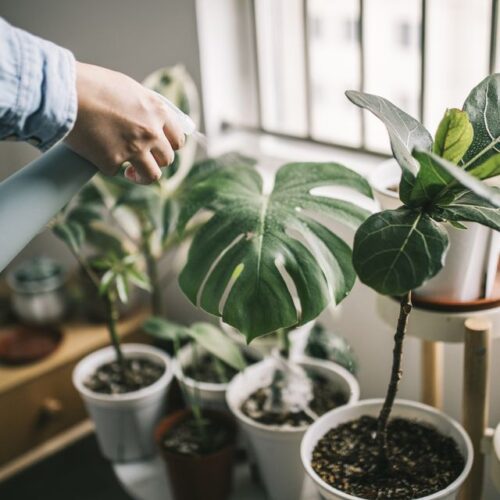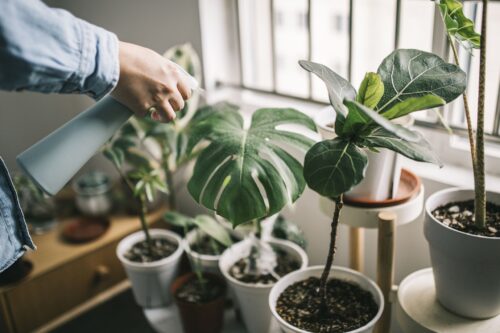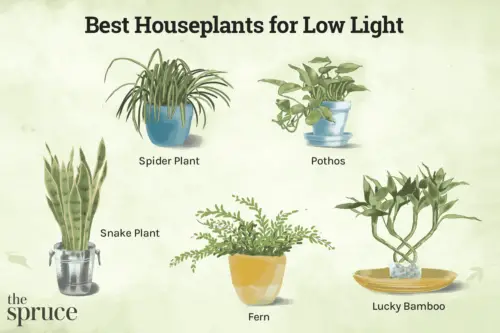To help plants grow in low light conditions, choose plants known for thriving in such environments, such as peace lilies, spider plants, or snake plants. You can also place plants near windows or use artificial grow lights to supplement natural light.
Additionally, rotating plants frequently helps them receive even light exposure, and consistently dusting their leaves ensures maximum light absorption. Welcome to the world of indoor gardening, where the challenges of low light conditions present an exciting opportunity for creativity and problem-solving.
In this guide, we’ll explore a variety of techniques to help your plants thrive in less than ideal light situations. From choosing the right plants to providing artificial light and proper care, you’ll learn everything you need to know to keep your indoor garden green and vibrant. Let’s get started!
Choosing The Right Plants
Choosing the right plants is crucial when cultivating a thriving indoor garden in low light conditions.
Consider Low Light Tolerant Varieties
Aim to select plant species that are specifically adapted to flourish in environments with limited natural light.
- Peace Lily: Known for its resilience in low light and ability to purify the air.
- Snake Plant: Thrives in low light and requires minimal maintenance.
- Spider Plant: Adaptable to various light conditions and a popular choice for indoor spaces.
Evaluate Foliage Density
Opt for plants with lush and dense foliage as they can maximize the utilization of available light.
- English Ivy: Features dense foliage that can tolerate low light settings.
- ZZ Plant: Succulent-like leaves contribute to its ability to thrive in dimly lit areas.
- Cast Iron Plant: Recognized for its robust, dark green leaves that can thrive in low light environments.

Credit: www.housebeautiful.com
Optimizing Natural Light
When it comes to helping plants thrive in low-light conditions, optimizing natural light is essential. Here are some effective techniques to make the most of available light for your indoor plants.
Place Plants Near Windows
Placing plants close to windows can significantly improve their access to natural light. Position them within a few feet of a window to maximize the incident light they receive.
Use Mirrors To Reflect Light
If your indoor space lacks sufficient natural light, using mirrors to reflect light onto plants can be helpful. Position mirrors strategically to bounce light towards the plants, especially in areas where direct sunlight is limited.
Supplementing With Artificial Light
Supplementing with artificial light can be a game-changer for plants in low light conditions. With the right approach, you can effectively replicate the benefits of natural sunlight and promote healthy growth even in areas with minimal natural light. One of the most effective ways to achieve this is through the use of grow lights.
Introduce Grow Lights
Grow lights are specially designed artificial light sources that emit light suitable for plant photosynthesis and growth. They come in various types, including LED, fluorescent, and high-intensity discharge (HID) lights, and can be utilized to provide the necessary light spectrum for plants in low light conditions.
Select The Right Light Spectrum
When using grow lights, it’s crucial to select the appropriate light spectrum that caters to the specific needs of your plants. Different types of plants require different light spectrums during their growth stages, with options ranging from red light for flowering and fruiting to blue light for vegetative growth. Understanding the light requirements of your plants is essential for optimal growth and development.
Proper Watering Techniques
Discover effective watering techniques to help plants thrive in low light conditions. By providing the right amount of water, avoiding overwatering, and using well-draining soil, you can ensure your plants receive the hydration they need for healthy growth.
Avoid Overwatering
Ensure Adequate Drainage
Proper watering techniques are essential for helping plants thrive in low light conditions.
Avoid Overwatering
Monitor soil moisture levels closely to prevent overwatering. Avoid leaving plants in standing water.
Ensure Adequate Drainage
Use pots with drainage holes to prevent waterlogging. Consider adding a layer of gravel at the bottom of the pot for better drainage.
Caring For Low Light Plants
Discover tips on nurturing low light plants to thrive indoors. Enhance growth with suitable plant selection and strategic placement in your home. Learn essential care practices and simple techniques to support their development in low light conditions.
If you are a plant lover but live in a space with limited natural light, don’t worry! There are still plenty of plant options that can thrive in low light conditions. Caring for low light plants may require a little extra attention, but with the right techniques, you can help your plants grow and flourish. In this article, we will discuss two important aspects of caring for low light plants: regularly dusting leaves and monitoring for signs of light stress.
Regularly Dust Leaves
Dusting the leaves of your low light plants is an essential task to keep them healthy and thriving. Dust can accumulate on the leaves, blocking the sunlight that plants need to photosynthesize and grow. Regularly removing the dust will ensure that your plants can absorb as much light as possible, even in low light conditions.
Here are some tips for effectively dusting the leaves of your low light plants:
- Use a soft, damp cloth or sponge to gently wipe the leaves. This will help remove any dust or dirt that may have settled on them.
- Start from the top of the plant and work your way down, being careful not to damage any delicate leaves or stems.
- For larger plants with more leaves, consider using a handheld vacuum cleaner with a soft brush attachment to gently suck away the dust.
- Make sure to clean both the upper and lower surfaces of the leaves, as dust can accumulate on both sides.
- Repeat this process every two to four weeks, or as needed, to keep your low light plants clean and healthy.
Monitor For Signs Of Light Stress
Low light conditions can sometimes cause light stress in plants. To ensure your low light plants are thriving, it is important to monitor them closely for any signs of light stress. Look out for the following indicators:
- Yellowing or pale leaves: If your low light plants have yellow or pale leaves, it may be a sign that they are not receiving enough light. Consider adjusting their placement to a spot with slightly more natural light.
- Leggy growth: Leggy growth occurs when plants stretch and become spindly in an attempt to reach more light. To prevent this, you can rotate your low light plants every few weeks to promote more even growth.
- Lack of flowering or stunted growth: Insufficient light can also impact a plant’s ability to flower or grow to its full potential. If you notice these signs, it may be necessary to supplement the natural light with artificial light sources.
By being attentive to dusting the leaves and monitoring for signs of light stress, you can ensure that your low light plants receive the care they need to thrive. With a little extra effort, you can enjoy the beauty of healthy plants, even in spaces with limited natural light.

Credit: www.housebeautiful.com

Credit: www.thespruce.com
Frequently Asked Questions For How To Help Plants Grow In Low Light Conditions?
How Do You Keep Plants Alive In A Low Light Room?
To keep plants alive in a low light room, choose low-light tolerant plants like snake plants, pothos, or peace lilies. Avoid overwatering and make sure the pots have drainage holes. Rotate the plants regularly and occasionally move them to get some natural light.
How Is It Possible For Plants To Grow Faster In Low Light Condition?
Plants can grow faster in low light conditions by adjusting their growth patterns. They allocate more energy to elongating their stems and leaves to reach for light, rather than putting energy into producing flowers or fruits. This allows them to survive and continue growth in limited light situations.
How Do You Deal With Low Light Plants?
To deal with low light plants, place them near a window for natural light or use grow lights for added brightness. Rotate the plants regularly for even exposure and avoid overwatering to prevent root rot. Choose plants that thrive in low light conditions for easier care.
What To Do If Plants Don’t Get Enough Sun?
If plants don’t get enough sun, you should consider moving them to a sunnier spot or using artificial lights.
Conclusion
Boosting plant growth in low light conditions can be challenging. By following these tips, your plants can thrive: proper watering, choosing low-light tolerant plants, utilizing grow lights, and providing adequate nutrients. Remember, with the right techniques and care, your indoor garden can flourish despite limited light exposure.
